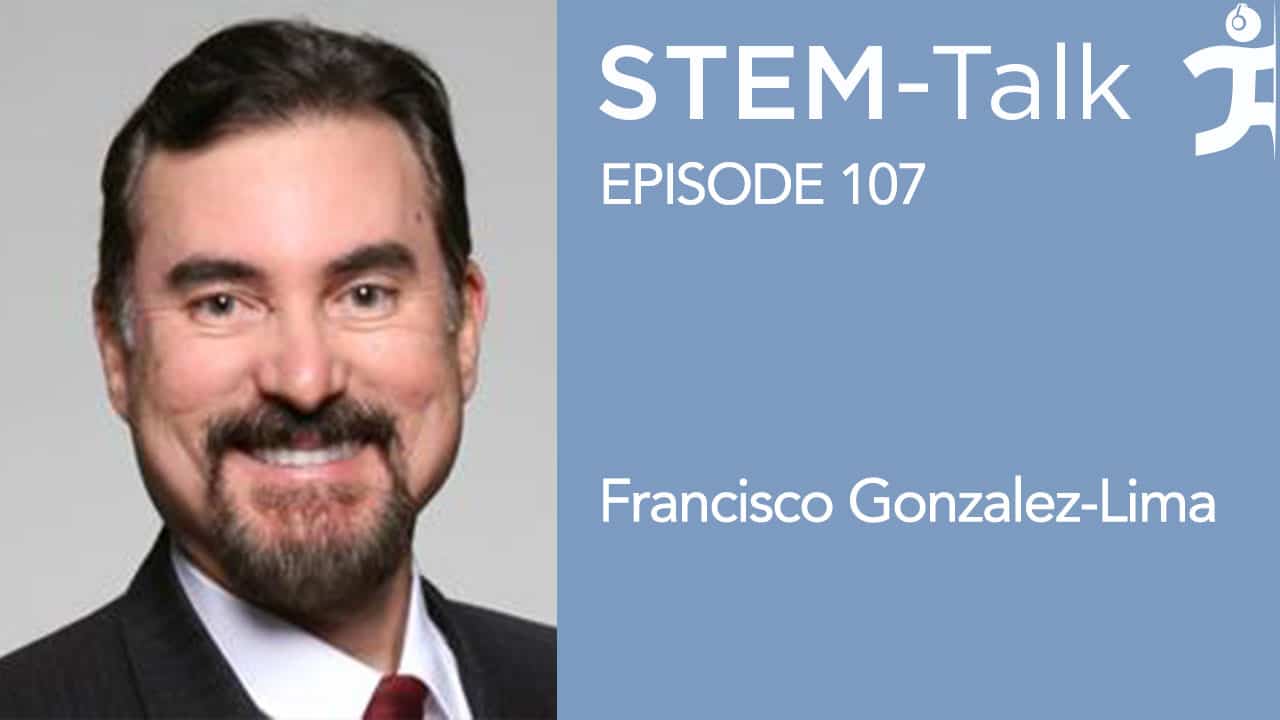STEM-Talk
Episode 107: Francisco Gonzalez-Lima discusses methylene blue and near-infrared light as therapies for cognitive disorders
// May 26, 2020

Today we have part two of our interview with Dr. Francisco Gonzalez-Lima, a behavioral neuroscientist at The University of Texas at Austin.
Francisco and his colleagues at the Gonzalez-Lima Lab are recognized as world leaders for their research on the relationship between brain energy metabolism, memory and neurobehavioral disorders.
Today’s interview focuses on two interventions Francisco has explored with the aim of protecting people against neurodegeneration: low-dose methylene blue and the application of near-infrared light. Part one of our interview, episode 106, touched on Francisco’s youth and training as well as his early research into Alzheimer’s disease and brain-metabolic mapping.
Over the years, much of Francisco’s brain research has focused on transcranial lasers, memory enhancement, neuroprotection, neurocognitive disorders. Current research in the Gonzalez-Lima Lab focuses on the beneficial neurocognitive and emotional effects of noninvasive human brain stimulation in healthy, aging and mentally ill populations. This research primarily uses transcranial infrared laser stimulation and multimodal imaging.
Show notes:
Today we have part two of our interview with Dr. Francisco Gonzalez-Lima, a behavioral neuroscientist at The University of Texas at Austin.
Francisco and his colleagues at the Gonzalez-Lima Lab are recognized as world leaders for their research on the relationship between brain energy metabolism, memory and neurobehavioral disorders.
Today’s interview focuses on two interventions Francisco has explored with the aim of protecting people against neurodegeneration: low-dose methylene blue and the application of near-infrared light. Part one of our interview, episode 106, touched on Francisco’s youth and training as well as his early research into Alzheimer’s disease and brain-metabolic mapping.
Over the years, much of Francisco’s brain research has focused on transcranial lasers, memory enhancement, neuroprotection, neurocognitive disorders. Current research in the Gonzalez-Lima Lab focuses on the beneficial neurocognitive and emotional effects of noninvasive human brain stimulation in healthy, aging and mentally ill populations. This research primarily uses transcranial infrared laser stimulation and multimodal imaging.
[00:04:15] Ken begins part two of our interview mentioning he would like to talk about low-dose methylene blue and the application of near-infrared light. Ken explains that Both of these interventions act by a similar cellular mechanism that targets mitochondrial respiration via the electron transport chain. Ken asks Francisco to describe for listeners what the electron transport chain is and why it is important to the function of the mitochondria. [00:08:22] Dawn asks what the clinical signs and symptoms of unhealthy mitochondrial function are, and what are markers of good mitochondrial health. [00:11:41] Francisco gives an overview of the drug methylene blue, and its mechanism of action. [00:15:02] Ken asks about the origin and history of methylene blue. [00:17:19] Dawn asks about the potential use of methylene blue as treatment for traumatic brain injury. [00:21:10] Ken asks how methylene blue might stimulate neurogenesis. [00:22:42] Dawn mentions that acute brain injury such as stroke and traumatic brain injury involves the upregulation of multiple stress-related responses, she asks how the addition of a hermetic stressor such as methylene blue alters this process. She goes on to ask if there would be an optimal window of time to administer this drug relative to the injury for optimal recovery of function. [00:23:48] Ken asks if methylene blue could be used by an individual before they engage in something that is likely to lead to brain damage, such as boxing, sports, or military operations. [00:26:32] Ken asks about the future of methylene blue in the treatment and prevention of neurodegeneration. [00:29:37] Ken asks if compounding pharmacies are producing oral forms of methylene blue. [00:32:17] Francisco addresses the issue of oral versus intravenous administration of methylene blue, and if there is an optimal mode of administration for brain targeted therapy. [00:36:15] Dawn asks about the potential use of methylene blue to protect against radiation poisoning. [00:38:32] Francisco explains how the beneficial effects of transcranial lasers were discovered. [00:42:11] Ken mentions that transcranial absorption of photon energy up-regulates cortical cytochrome oxidase and enhances oxidative phosphorylation. Low level near-infrared light improves prefrontal cortex-related cognitive functions, such as sustained attention, extinction memory, working memory, and affective state. Ken asks Francisco to talk about the use of near infrared light as a targeted treatment for cognitive decline and neurodegenerative disorders. [00:45:37] Dawn mentions that Francisco’s work and that of others suggests that low-level laser therapy stimulates the production of mitochondrial matrix water, which is depleted in deuterium. Dawn asks if this deuterium depletion could result in enhanced genomic stability and epigenetic effects. [00:48:00] Ken asks about the use of methylene blue and ketone esters for performance in elite warfighters. [00:49:08] Dawn brings up the Neurotherapy Effectiveness and Safety Trial (NEST), a clinical trial which successfully used laser therapy to treat acute stroke patients. She goes on to mention that the phase III of the trial was suspended at the half-way point due to lack of significance. Francisco talks about these trials and why they didn’t end up being successful. [00:51:22] Ken asks Francisco how quickly transcranial laser therapy can alter mood or cognition. [00:51:47] Ken asks what Francisco’s thoughts are on whole-body low-level laser therapy, such as Erchonia’s system, for musculoskeletal pain or the NovoTHOR pod. [00:52:29] Ken asks how does one develop a dosing protocol for near-infrared light, and if overuse of commercially available low-level laser therapy units lead to side effects or unfavorable responses. [00:53:31] Dawn asks if there are nutritional, medicinal, or other strategies that could be synergistic with either near infrared light or methylene blue. [00:54:38] Dawn mentions that both methylene blue and various cranial laser therapy devices are available commercially online. She asks if these are comparable with what has been used for research and if these procedures are ready for at-home use by the general public. [00:56:14] Francisco closes the interview explaining why he describes himself as a survivor and someone who is a testament to the American dream.Links:






